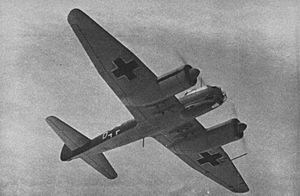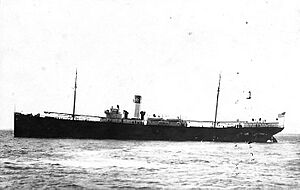Convoy QP 10 facts for kids
Convoy QP 10 was a group of ships that sailed during World War II. These ships were returning from the Soviet Union after delivering important supplies there. They were empty and heading back home. The convoy had 16 merchant ships, which are like cargo ships, and nine warships to protect them.
The convoy left Murmansk on April 10, 1942. Their journey ended in Reykjavik, Iceland, on April 21. Along the way, German U-boats (submarines) and airplanes attacked the convoy. Four merchant ships were sunk, and one ship, Stone Street, was damaged and had to turn back. The warships protecting the convoy fought back, shooting down six German planes and damaging another. Later, six more merchant ships joined Convoy QP 10 after facing problems in another convoy called PQ 14.
Contents
What was Convoy QP 10?
Convoy QP 10 was a special group of ships during World War II. It was part of the "Arctic convoys," which were dangerous journeys through icy waters. These convoys carried vital supplies to the Soviet Union to help them fight in the war. Once the supplies were delivered, the ships needed to return home. Convoy QP 10 was one of these return trips.
The Ships and Their Protectors
The convoy started with 16 merchant ships. These were cargo ships carrying no goods on their way back. To keep them safe, nine warships sailed alongside them. These protectors included the cruiser HMS Liverpool, and several destroyers like HMS Oribi and Punjabi. There was also a minesweeper called Speedwell and two trawlers, Blackfly and Paynter.
For the first few days, from April 10 to April 12, the convoy had even more help. Two Soviet destroyers, Gremyashchi and Sokrushitelny, joined the escort. Three more minesweepers, Gossamer, Harrier, and Hussar, also helped. Far away, a powerful group of large warships, including battleships Duke of York and King George V, and the aircraft carrier Victorious, were also in the area. However, they were too far to directly protect the convoy from attacks.
The Dangerous Journey Begins
Convoy QP 10 left Murmansk in the late afternoon of April 10. The journey was long and cold. The first attacks began on April 11. German Ju 88 bombers flew over the convoy. They dropped bombs on the ships below.
First Attacks from the Sky
The merchant ship Empire Cowper was hit by three bombs. As the crew tried to leave the ship, two more bombs struck. HMS Paynter, one of the escort ships, quickly rescued the survivors. Sadly, the Empire Cowper then sank. Another merchant ship, Harpalion, bravely fought back. Its crew managed to shoot down one of the attacking Ju 88 planes.
Underwater Threats
In the early morning of April 13, a German U-boat called U-435 attacked the convoy. The Russian cargo ship Kiev was hit by a torpedo and sank quickly. About two and a half hours later, U-435 struck again. This time, it hit El Occidente, which also sank almost immediately.
Later that morning, more Ju 88 planes appeared. They flew around the convoy for about an hour before starting their attacks. The ship Harpalion was attacked many times from the air. Its steering system was badly damaged, and its rudder broke. The crew tried to fix the rudder, but four Ju 88s flew low, firing machine guns at the ship's deck. Because the ship was too damaged to continue, HMS Fury had to sink Harpalion to prevent it from falling into enemy hands. This is called "scuttling."
German destroyers, Hermann Schoemann, Z24, and Z25, tried to find the convoy on April 12 and again on April 13. However, bad weather and their search efforts failed, so they turned back.
Joining Forces
After these attacks, the convoy was not attacked again. Later in the journey, six more ships joined Convoy QP 10. These ships were originally part of another convoy called PQ 14. They had to turn back because of thick ice and severe weather damage. Joining QP 10 allowed them to continue their journey home safely.
Images for kids





